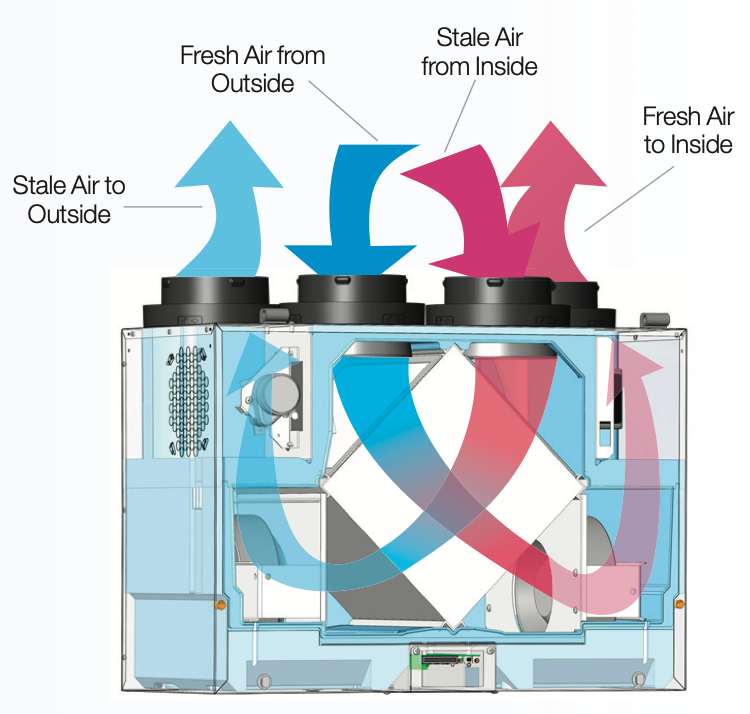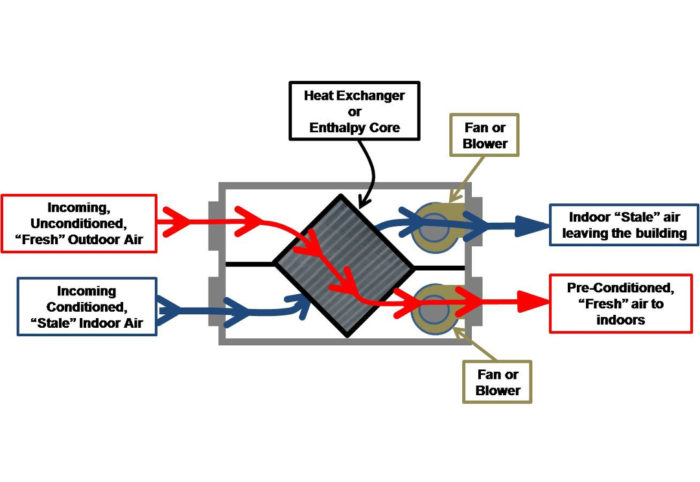How Long Does HRV Perform? Understanding System Lifespan
Wiki Article
Introducing the Secret Benefits and Uses of Heat Recovery Ventilation in Lasting Design
Heat Recovery Ventilation (HRV) systems play an essential function in sustainable style. They promote a constant exchange of stagnant interior air with fresh exterior air, significantly enhancing interior air top quality. HRVs add to energy efficiency by reclaiming heat from tired air, which can reduce utility expenses. Comprehending the complex benefits and applications of HRVs discloses their relevance in modern-day style. What various other advantages do these systems offer in the pursuit of sustainability?Understanding Heat Recovery Ventilation Equipments
Heat recovery ventilation (HRV) systems are made to improve indoor air quality while minimizing energy loss. These systems make use of a mechanical air flow strategy to exchange stagnant indoor air with fresh outdoor air, guaranteeing a constant supply of clean air. By catching heat from the exhaust air, HRVs precondition inbound air, reducing the demand on heating and cooling systems. This process not just improves thermal convenience yet likewise contributes to energy effectiveness in property and industrial buildings. In addition, HRV systems assist control moisture levels and lower interior pollutants, advertising a healthier living environment. Their critical application is important for attaining lasting design objectives, as they provide an equilibrium between power conservation and resident well-being.Exactly How HRV Systems Job
While many might know with air flow systems, understanding how warm recovery air flow (HRV) systems operate is crucial for appreciating their advantages. HRV systems work by trading stale interior air with fresh exterior air while transferring warmth between the 2 streams. This procedure occurs in a warmth exchanger, where heat from the outbound air warms up the incoming air throughout cooler months, decreasing energy loss. On the other hand, in warmer months, the system can cool down incoming air utilizing the cooler outbound air. HRVs are equipped with fans to help with air flow and filters to get rid of particulates, guaranteeing a continual, well balanced ventilation process. This ingenious style not only improves energy performance but also adds to preserving a comfy indoor atmosphere.Enhancing Indoor Air High Quality
Interior air top quality can significantly influence wellness and health, making reliable ventilation necessary in modern-day homes. Heat Recovery Ventilation (HRV) systems play an important function in preserving indoor air high quality by constantly exchanging stale indoor air with fresh outdoor air. This process not only decreases airborne contaminants yet also minimizes moisture degrees, which can bring about mold and mildew development and breathing problems. HRV systems filter inbound air, getting rid of irritants and particulates, therefore giving a much healthier living setting. In addition, these systems assist remove smells and unstable organic compounds (VOCs) commonly located in house products. By making sure a constant flow of tidy air, HRV systems add to a general enhanced indoor ambience, promoting comfort and health for owners.Power Performance and Expense Cost Savings
Power performance sticks out as a significant advantage of Heat Recovery Ventilation (HRV) systems. By recording and reusing the heat from worn down indoor air, HRVs minimize the energy required for heating inbound fresh air, causing reduced power usage. This effectiveness converts into reduced energy expenses, offering considerable price savings for home owners and organizations alike. Additionally, HRV systems typically get power performance rewards and rebates, even more boosting their financial allure. With time, the initial financial investment in HRV modern technology can cause a positive return on financial investment through reduced power costs. Subsequently, the assimilation of HRV systems not only advertises sustainable layout but also supplies a practical service for accomplishing lasting power savings and financial benefits.Ecological Benefits of HRV

A plethora of environmental benefits occurs from the application of Heat Recovery Ventilation (HRV) systems. By effectively moving warmth from exhaust air to incoming fresh air, HRVs substantially lower the power needed for home heating and cooling down rooms. This power performance translates to reduce greenhouse gas discharges, adding to a decline in the total carbon impact of structures. Furthermore, HRV systems boost interior air top quality by continually distributing fresh air, consequently minimizing the focus of indoor contaminants and allergens. The decrease in energy consumption help in preserving natural resources, making HRVs an essential part of lasting design. Overall, the ecological advantages of HRVs play a vital duty in promoting a healthier earth and promoting green building techniques.
Versatile Applications in Modern Architecture
Heat recovery ventilation (HRV) systems are significantly being incorporated into both residential and business architectural tasks. In property setups, HRVs improve interior air high quality while taking full advantage of energy performance. In business spaces, these systems enhance ventilation approaches, demonstrating their convenience in modern-day building applications.Residential Projects Combination
While modern-day design significantly emphasizes sustainability, the integration of warmth recovery ventilation systems in property tasks has become a sensible solution for improving indoor air top quality and power efficiency. These systems effectively transfer warm from exhaust air to inbound fresh air, minimizing energy loss and minimizing home heating or cooling down needs. In brand-new builds and retrofits alike, heat recovery ventilation can be flawlessly integrated, providing house owners with a much healthier living setting while lowering utility prices. In addition, with increasing recognition of environmental impacts, even more engineers and contractors are identifying the long-lasting benefits of these systems. As a result, heat healing air flow has come to be an essential component of sustainable domestic design, showcasing adaptability and dedication to environment-friendly techniques.Business Areas Optimization
As contemporary industrial areas progress to fulfill the demands of sustainability and effectiveness, the execution of warm recovery air flow systems emerges as a key approach for maximizing indoor atmospheres. These systems assist in the exchange of stagnant indoor air with fresh outdoor air while reclaiming warmth power, significantly reducing power usage. This not just improves convenience for residents yet likewise helps in lowering functional costs. Functional applications can be observed in offices, retail rooms, and educational organizations, where air quality and temperature level control are vital. In addition, incorporating warm recuperation air flow straightens with green structure certifications, further advertising ecological responsibility. Ultimately, embracing such systems in business architecture not just adds to sustainability goals however additionally fosters healthier, a lot more effective spaces for individuals.
Incorporating HRV Into Sustainable Layout Practices
Incorporating warmth recuperation air flow (HRV) systems right into lasting style methods uses considerable benefits in energy performance and interior air top quality. By making use of HRV, developers can produce economical options that not only decrease energy intake yet likewise improve the general comfort of interior settings. This positioning with sustainability goals settings HRV as an important component in modern-day building techniques.
Energy Efficiency Improvement
By integrating heat recuperation air flow (HRV) systems into sustainable layout techniques, designers and contractors can significantly improve energy performance in modern-day building and constructions. HRV systems work by catching heat from outward bound stale air and transferring it to inbound fresh air, reducing the power needed for heating or cooling down indoor rooms. This procedure not only lowers reliance on traditional HVAC systems yet likewise decreases general power consumption. In enhancement, HRV systems can assist maintain a regular indoor temperature level, reducing peak power needs. By integrating these systems, structures can achieve substantial reductions in energy costs and carbon impacts, aligning with sustainability goals. Inevitably, HRV technology represents a sensible option for boosting power effectiveness in the built atmosphere, advertising even more liable resource use.Indoor Air High Quality Renovation
Just how can warm recovery ventilation (HRV) systems add to remarkable interior air quality in modern-day buildings? HRV systems efficiently exchange stagnant indoor air with fresh exterior air while recuperating heat, reducing temperature level variations. This process lowers the focus of interior contaminants, such as unpredictable natural substances (VOCs), irritants, and dampness, which can deteriorate air top quality and influence passenger health. By maintaining optimal humidity levels and making sure a constant supply of clean air, HRVs assist create a healthier indoor atmosphere. Furthermore, these systems can be integrated into lasting layout techniques, advertising power effectiveness together with improved air quality. HRV Heat Recovery Ventilation. As a result, HRV innovation plays a crucial function ahead of time overall occupant convenience and wellness in modern building layoutsEconomical Design Solutions

Often Asked Inquiries
What Maintenance Is Needed for Heat Recovery Ventilation Systems?

Maintenance for warmth healing air flow systems typically includes routine filter substitutes, cleansing of heat exchangers, evaluation of followers and air ducts, and making sure correct drain. These tasks aid keep efficiency and prolong the system's lifespan over time.
Can HRV Systems Be Mounted in Existing Buildings?
Heat recovery ventilation systems can certainly be set up in existing buildings. HRV Heat Recovery Ventilation. Retrofitting calls for careful planning and evaluation of the building's layout, guaranteeing compatibility with current systems while making best use of power effectiveness and indoor air qualityHow Do HRV Systems Influence Noise Levels Inside?
HRV systems can influence interior sound degrees by introducing noise from external resources with ventilation. Nevertheless, top quality installments often incorporate sound-dampening attributes, decreasing sound influence while supplying effective air exchange and maintaining convenience inside your home.Are There Any Kind Of Drawbacks to Using HRV Equipments?
The drawbacks of using HRV systems consist of possible high preliminary prices, maintenance obstacles, and the possibility of reduced interior air high quality if filters are sporadically transformed, which might bring about issues with moisture degrees.How Do I Select the Right HRV System for My Demands?
Choosing the ideal heat healing air flow system entails assessing certain demands, such as developing dimension, climate, and energy effectiveness objectives. In addition, evaluating system functions, installment needs, and maintenance considerations is important for peak efficiency and fulfillment.Report this wiki page